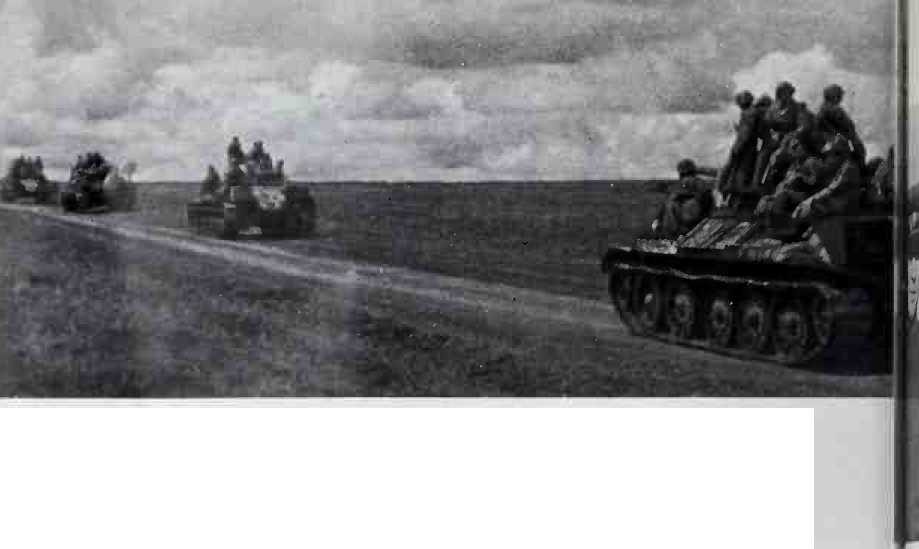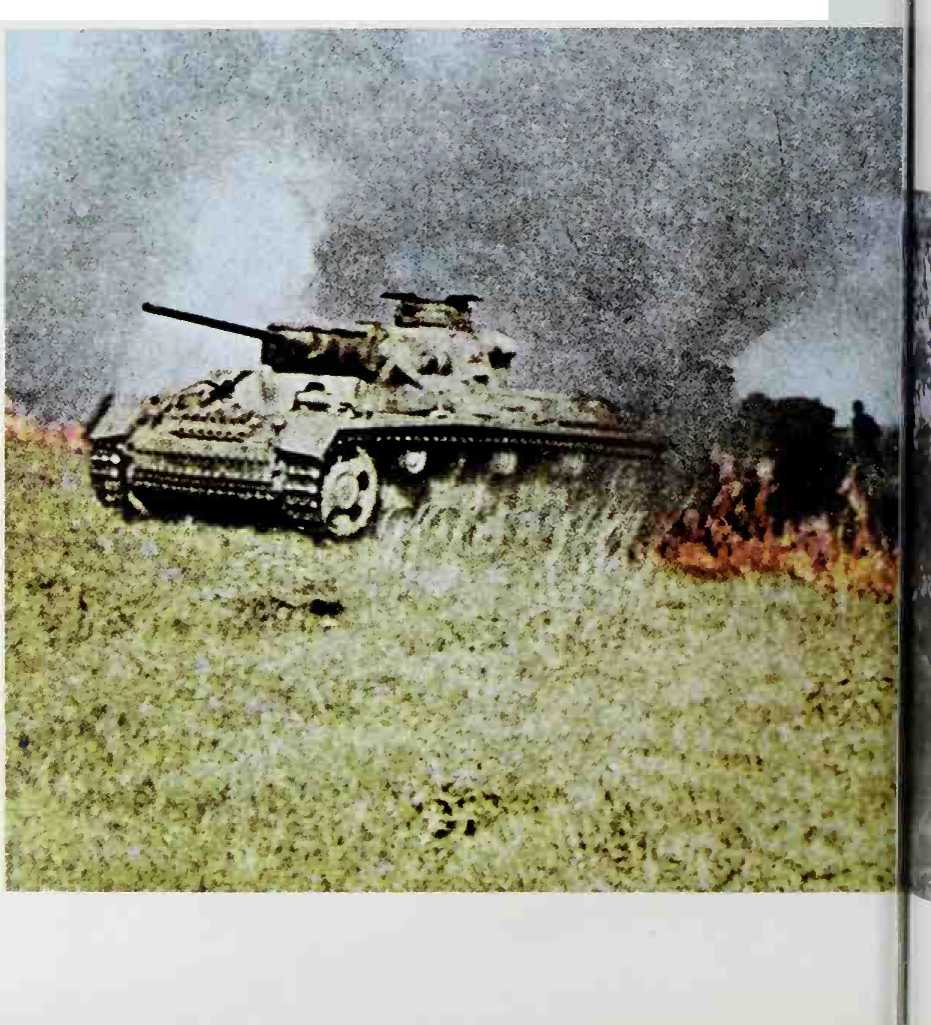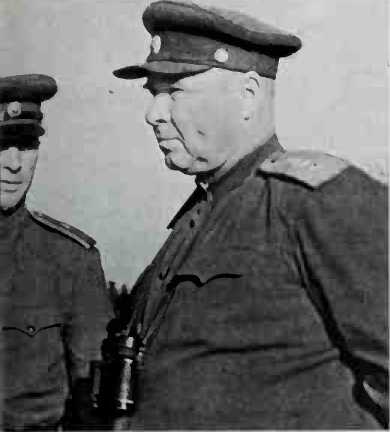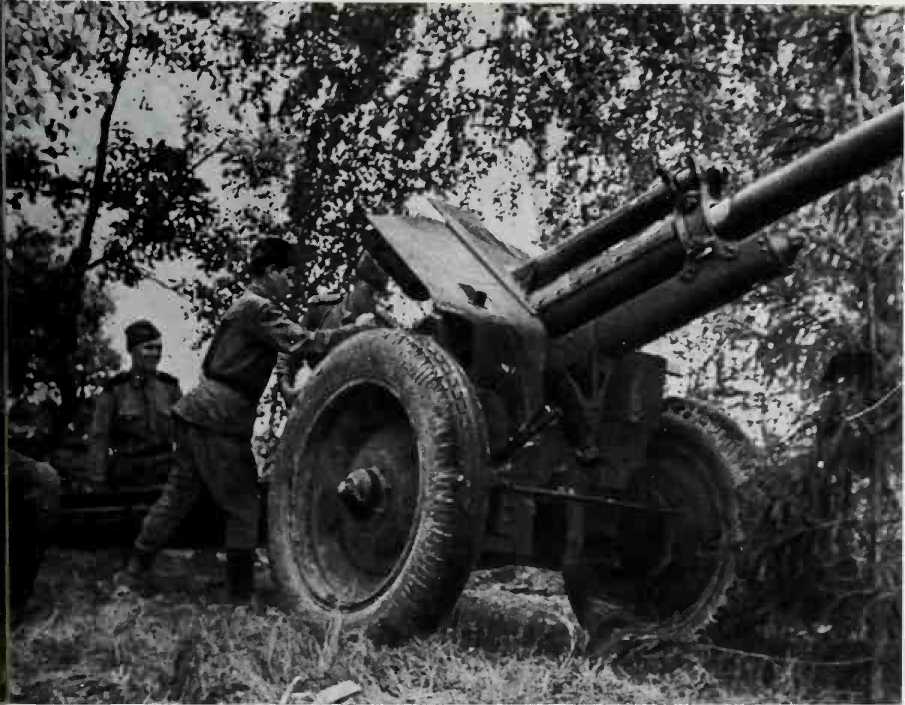Now that most of the pieces on the chessboard are in place we can deal quickly with the actual sequence of events in the Battle of Kursk which, on July 12, ended in an irreversible defeat for the Wehrmacht. Far from taking the enemy by surprise, the German 9th Army, following close on the desertion mentioned above, was itself surprised by a massive artillery counter-barrage, which struck its jump-off points in the final stages of preparation 20 minutes before zero hour. By evening, XLVII and XLI Panzer Corps, consisting of seven armoured divisions, had advanced only six miles across the defences of the Soviet 13th Army, and their 90 "Ferdinands” or ’’Elefants”, being without machine guns, were unable to cope with the Russian infantry. More important, XXIII Corps, guarding the left flank, was stopped short of Malo-Arkhangelsk. On July 7, spurred on by the vigorous leadership of General Rauss, XLVII Panzer Corps reached the

A Soviet infantry and tanks approaching the Kursk area. The Russians were able to keep their reserves undamaged until the Germans had driven themselves to breaking point on the fixed defences in the Kursk salient, and then the Red Army went on to the counter-attack.
Outskirts of Olkhovatka, less than 12 miles from its start line. There the German 9th Army was finally halted.
Army Group "South’s” part of "Zita-delle” got off to a better start, thanks largely to impeccable co-ordination between tanks and dive-bombers. In the course of engagements which Manstein in his memoirs describes as extremely tough, Gruppe Kempf succeeded in breaking through two defence lines and reaching a point where it could intercept Steppe Front reinforcements coming to the aid of Voronezh Front. On July 11 the situation might be thought to be promising.
For 48 hours the 4th Panzerarmee met a solid wall of resistance of which General F. W. von Mellenthin, at that time chief-of-staff to XLVIII Panzer Corps, provides the following description in his book Panzer Battles:
"During the second and third days of the offensive we met with our first reverses. In spite of our soldiers’ courage and determination, we were unable to find a gap in the enemy’s second defence line. The PanzergrenadierY)wsox "Grossdeut-schland” (Lieutenant-General Hoerlein) which had gone into battle in extremely tight formation and had come up against an extremely marshy tract of ground, was stopped by prepared fortifications defended with anti-tank guns, flame-throwers, and T-34 tanks, and was met by violent artillery fire. For some time it remained unable to move in the middle of the battlefield devised by the enemy. It was no easy task for our pioneers to find and fix a passable route through numerous minefields or across the tracts of marshland. A large number of tanks were blown up by mines or destroyed by aerial attacks: the Red Air Force showed little regard for the fact of the Luftwaffe’s superiority and fought the battle with remarkable determination and spirit.”
On July 7, however, XLVIII Panzer Corps and on its right II Waffen S. S. Panzer Corps found themselves unopposed, after repulsing heavy counterattacks by tr, iks which developed as pincer move<TLents. Thus on July 11, after establish, ng a bridgehead on the Psel and getting close to Oboyan, the 4th Panzerarmee had advanced 18 to 20 miles through Vatutin’s lines, while Gruppe Kempf, without having been able to land on the western bank of the Korocha had nevertheless managed to fulfil its primary task of protecting the 4th Panzerarmee’s right flank. Two days later, Manstein reported that since D-day he had taken 24,000 prisoners and destroyed or captured 100 tanks and 108 anti-tank guns, and intended to move up his reserve, XXIV Panzer Corps.
These, however, were limited successes and "Zitadelle” was a serious reverse for Hitler. Between the spearhead of the 4th Panzerarmee, on the edge of Oboyan, and the vanguard of the 9th Army, forced to halt before Olkhovatka, the gap between the two armies remained, and would remain, 75 miles.
Far from feeling discouragement, Vatutin made known to Stavka in the evening of July 10 his intention of counterattacking, and bringing up for this pur-
V A Pzkw III emerges from the smoke of a grass fire during the opening stages o/"Zitadelle”. The operation was to squander the tanks and vehicles that Guderian had built up.


A Lieutenant-General Rotmistrov and Major-General Rodimtsev. Rotmistrov commanded the 5th Guards Tank Army in the Battle of Kursk. He brought it by forced marches over 200 miles and then after a heavy bombardment sent in his force of 850 tanks and assault guns against Hausser’s II S. S Panzer Corps, which was fighting in the Prokhorovka area.
V A Soviet 76-mm gun crew prepares to fire. Before the Germans moved off from their start lines on the first day of Kursk, they were subject to a morale-shattering bombardment.

Pose his 5th Guards Tank Army (Lieutenant-General P. A. Rotmistrov) with its 850 tanks and assault guns, as well as the 1st Tank Army (Lieutenant-General
M. E. Katukov).
On the other side of the battlefield, Rokossovsky addressed the following rousing order of the day to his troops on July 12: "The soldiers of the Central Front who met the enemy with a rampart of murderous steel and truly Russian grit and tenacity have exhausted him after a week of unrelenting and unremitting fighting; they have contained the enemy’s drive. The first phase of the battle is over.”
And indeed, on that same July 12, the Soviet armies of the Bryansk and West Front, following a predetermined plan, proceeded to launch a major offensive against the German-held Orel salient.




 World History
World History









